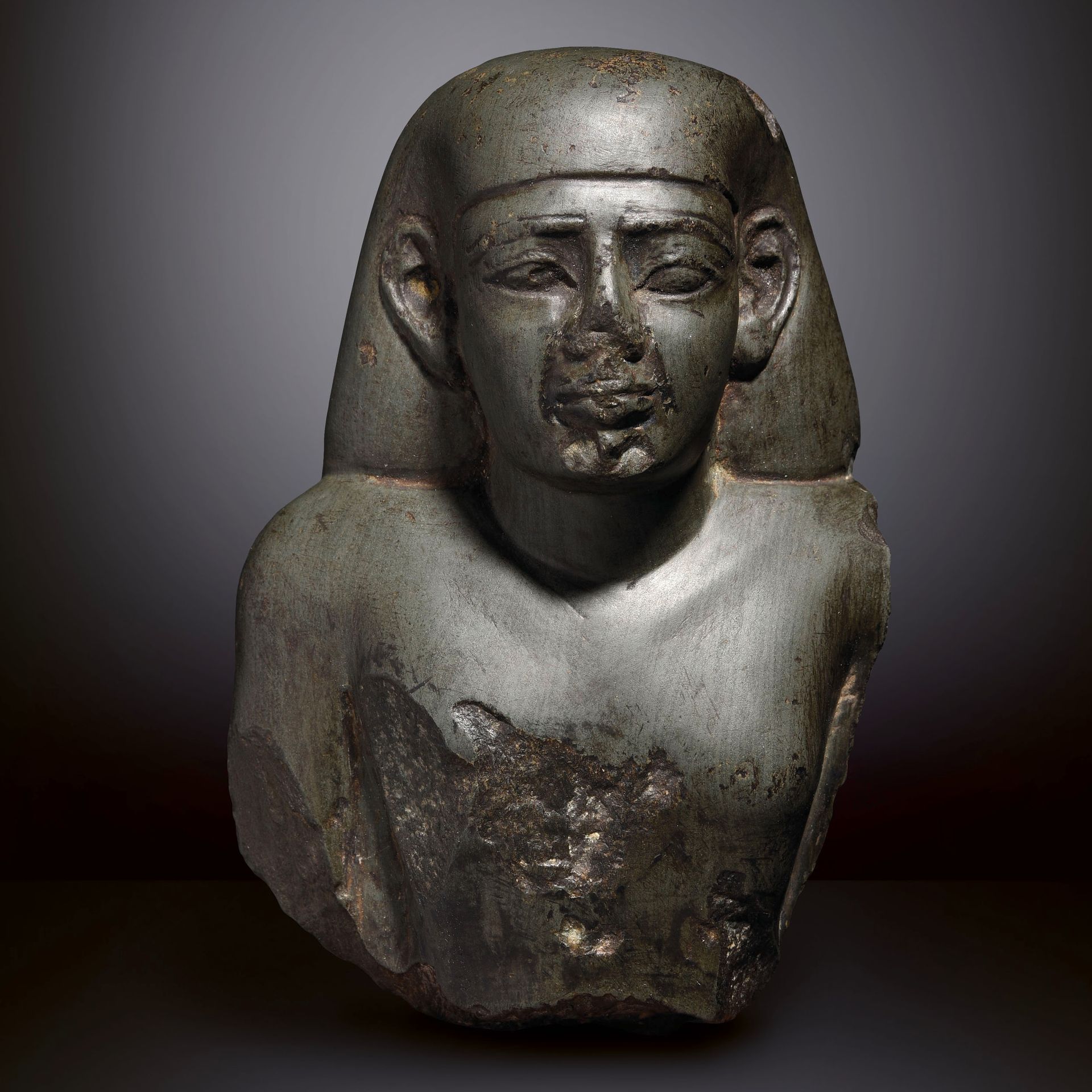Description
BUST OF A CRAB Egypt, XXVIth dynasty, c. 525 B.C. Grauwacke. On the back, collection number "573" in red H. 17 cm Provenance Former Belgian collection, 1960s European private collection This beautiful bust was probably part of a statue representing a young male figure. Characterized by a rounded face, the eyes are stretched at each corner, underlined by kohol. The thick eyebrows are specified in relief. The nose is very thin with a bridge that thickens towards the bottom (partially damaged). The mouth is fleshy. The head (probably shaved) is covered with a wig slightly flared on the sides and ending at the shoulders. The large ears are free. The torso is bare (only part of the right arm remains) and the clavicles are visible. At the back, there is a dorsal pillar inscribed with a hieroglyphic column (fragmentary) where one can read = Sa-Nit Sa-Neith. A similar mention is present on a fragmentary statue of an Administrator of the Domain of Neith and preserved in the Metropolitian Museum, inv. 1976.325 and dated to about 600 BC. At the time when the fusion of styles between the North and the South of Egypt found a state of harmony. A saite green schist bust of a dignitary. This very beautiful bust was probably part of a statue of a young male figure. Characterized by a rounded face, the eyes are stretched out at each corner, highlighted by kohol. The thick eyebrows are detailed in relief. The very thin nose at the ridge thickens downwards (partially damaged). The mouth is fleshy. The head (probably shaved) is covered with a bag wig" slightly flared to the side and ending at the shoulders. The large ears are uncovered. The torso is bare (only part of the right arm remains) and the collarbones are visible. The back with a dorsal pillar inscribed with a hieroglyphic column (fragmentary) where we can read = Sa-Nit Sa-Neith. A similar mention is present on a fragmentary statue of an Administrator of the Domain of Neith and preserved in the Metropolitian Museum (fig. 1) and dated to around 600 B.C. At the time when the fusion of styles between the North and the South of Egypt finds a state of harmony. Dynasty XXVI, ca. 664-525 B.C
39
BUST OF A CRAB Egypt, XXVIth dynasty, c. 525 B.C. Grauwacke. On the back, collection number "573" in red H. 17 cm Provenance Former Belgian collection, 1960s European private collection This beautiful bust was probably part of a statue representing a young male figure. Characterized by a rounded face, the eyes are stretched at each corner, underlined by kohol. The thick eyebrows are specified in relief. The nose is very thin with a bridge that thickens towards the bottom (partially damaged). The mouth is fleshy. The head (probably shaved) is covered with a wig slightly flared on the sides and ending at the shoulders. The large ears are free. The torso is bare (only part of the right arm remains) and the clavicles are visible. At the back, there is a dorsal pillar inscribed with a hieroglyphic column (fragmentary) where one can read = Sa-Nit Sa-Neith. A similar mention is present on a fragmentary statue of an Administrator of the Domain of Neith and preserved in the Metropolitian Museum, inv. 1976.325 and dated to about 600 BC. At the time when the fusion of styles between the North and the South of Egypt found a state of harmony. A saite green schist bust of a dignitary. This very beautiful bust was probably part of a statue of a young male figure. Characterized by a rounded face, the eyes are stretched out at each corner, highlighted by kohol. The thick eyebrows are detailed in relief. The very thin nose at the ridge thickens downwards (partially damaged). The mouth is fleshy. The head (probably shaved) is covered with a bag wig" slightly flared to the side and ending at the shoulders. The large ears are uncovered. The torso is bare (only part of the right arm remains) and the collarbones are visible. The back with a dorsal pillar inscribed with a hieroglyphic column (fragmentary) where we can read = Sa-Nit Sa-Neith. A similar mention is present on a fragmentary statue of an Administrator of the Domain of Neith and preserved in the Metropolitian Museum (fig. 1) and dated to around 600 B.C. At the time when the fusion of styles between the North and the South of Egypt finds a state of harmony. Dynasty XXVI, ca. 664-525 B.C
